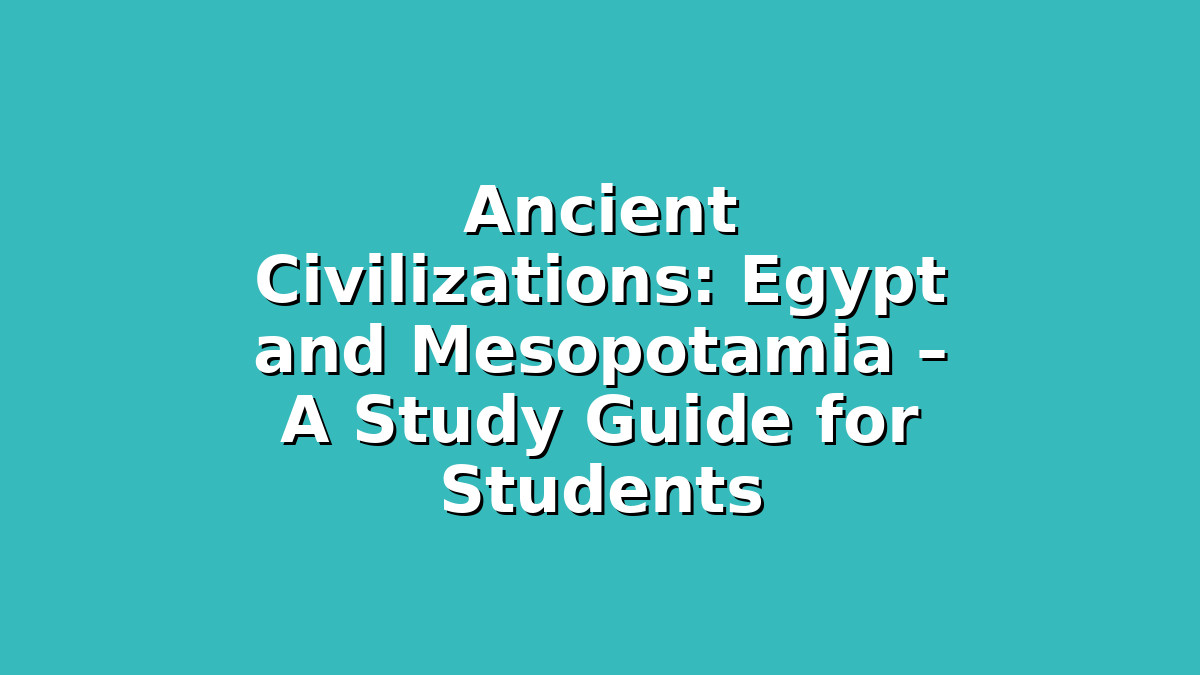If you’re a student preparing for history exams or looking to deepen your understanding of ancient civilizations, two of the most fascinating and foundational cultures to explore are Ancient Egypt and Mesopotamia. These early societies laid the groundwork for many aspects of modern civilization, from writing systems to governance, and their stories continue to captivate learners worldwide. This article will guide you through the key features of these ancient civilizations and provide practical study tips to help you absorb and retain important information efficiently.
Introduction to Ancient Civilizations
Ancient civilizations are the earliest complex societies that developed advanced cities, social structures, economies, and cultural achievements. Among these, Egypt and Mesopotamia stand out as some of the earliest and most influential. Both emerged around river valleys — the Nile for Egypt and the Tigris and Euphrates for Mesopotamia — which provided fertile land and resources crucial for their growth.
Understanding these civilizations is essential not only for exams but also for appreciating how human societies evolved over time. Let’s dive into the unique characteristics of both Egypt and Mesopotamia, along with effective tips to help you master this topic for your next test.
—
1. Ancient Egypt: The Gift of the Nile and Lasting Legacy
#### Key Features to Remember
Ancient Egypt is often called “The Gift of the Nile,” a phrase coined by historian Herodotus to emphasize the central role the Nile River played in Egyptian life. The Nile’s predictable flooding allowed Egyptians to develop a stable agricultural system that supported large populations and monumental architecture.
Some important points about Ancient Egypt include:
– Geography: Located in northeastern Africa, centered around the Nile River.
– Government: Ruled by Pharaohs who were considered divine kings.
– Religion: Polytheistic, with gods like Ra (the sun god) and Osiris (god of the afterlife).
– Writing: Hieroglyphics, a complex system of picture writing used for religious texts and official records.
– Achievements: Pyramids, temples, advances in medicine, mathematics, and calendar systems.
#### Study Tips for Egypt
– Create Timelines: Ancient Egyptian history spans over 3,000 years. Making a timeline can help you visualize major periods like the Old Kingdom (age of pyramid-building), Middle Kingdom, and New Kingdom (empire expansion and famous pharaohs like Ramses II).
– Use Flashcards for Vocabulary: Terms like “pharaoh,” “hieroglyphics,” “mummification,” and “Nile” are essential. Flashcards can reinforce key vocabulary and their meanings.
– Watch Documentaries or Videos: Visual stories about the pyramids, mummies, and gods make the material more memorable. Websites like Khan Academy or National Geographic offer student-friendly videos.
– Practice Drawing: Sketch simple hieroglyphics or the layout of the Nile Valley. Drawing helps engage your brain through active learning.
—
2. Mesopotamia: The Cradle of Civilization
#### Key Features to Remember
Mesopotamia means “the land between rivers,” referring to the Tigris and Euphrates in modern-day Iraq. This region is considered the “Cradle of Civilization” because many firsts happened here: the earliest cities, the invention of writing, and the development of law codes.
Key aspects of Mesopotamia include:
– Geography: Located in the Fertile Crescent between the Tigris and Euphrates rivers.
– City-States: Independent cities like Ur, Uruk, and Babylon ruled by kings.
– Writing: Cuneiform, one of the earliest writing systems, used for record keeping and literature like the Epic of Gilgamesh.
– Law: The Code of Hammurabi, one of the first written legal codes.
– Religion: Polytheistic, with gods linked to natural forces like the sky, water, and storms.
#### Study Tips for Mesopotamia
– Summarize Key Concepts: Write short summaries about major topics like cuneiform or Hammurabi’s Code. Teaching the concept aloud to yourself or friends can deepen understanding.
– Compare and Contrast: Make a table comparing Egypt and Mesopotamia. For example, compare their governments, religions, writing systems, and achievements. This helps highlight similarities and differences, making both easier to remember.
– Use Mnemonics: Create memory aids for tricky facts. For instance, to remember Hammurabi’s Code, use a phrase like “Harsh Hammurabi Hands Out Laws” to recall that his code was strict and influential.
– Practice Past Exam Questions: Look for sample questions related to Mesopotamia. Writing answers helps apply what you’ve learned and reduces exam anxiety.
—
3. How to Effectively Study Ancient Civilizations for Exams
Studying history can sometimes feel overwhelming due to the volume of information. Here are some tested strategies tailored for students studying Ancient Egypt and Mesopotamia:
– Break Your Study Sessions: Use the Pomodoro technique—study for 25 minutes, then take a 5-minute break. This boosts focus and prevents burnout.
– Use Multiple Resources: Don’t rely solely on textbooks. Incorporate videos, podcasts, interactive quizzes, and even museum virtual tours to engage different learning styles.
– Form Study Groups: Collaborate with classmates to discuss topics. Teaching each other or quizzing one another reinforces knowledge.
– Create Mind Maps: Visualize the connection between ideas, such as how writing systems relate to government or religion.
– Practice Writing Essays: Many exams ask for explanations or comparisons. Practice outlining and writing essays on topics like “Compare the roles of religion in Egypt and Mesopotamia” or “Discuss the importance of river valleys.”
—
Conclusion
Ancient Egypt and Mesopotamia offer rich stories of human achievement, innovation, and culture that are essential for history students to understand. By focusing on their geography, government, religion, writing, and achievements, and by applying effective study techniques, you can conquer this topic with confidence. Remember, consistent and active studying is key to success. Use timelines, flashcards, visual aids, and practice questions to make your study sessions productive and enjoyable.
Keep a positive mindset—every piece of information you learn brings you closer to acing your exams and developing a lifelong appreciation for history. Good luck with your studies!

Responses